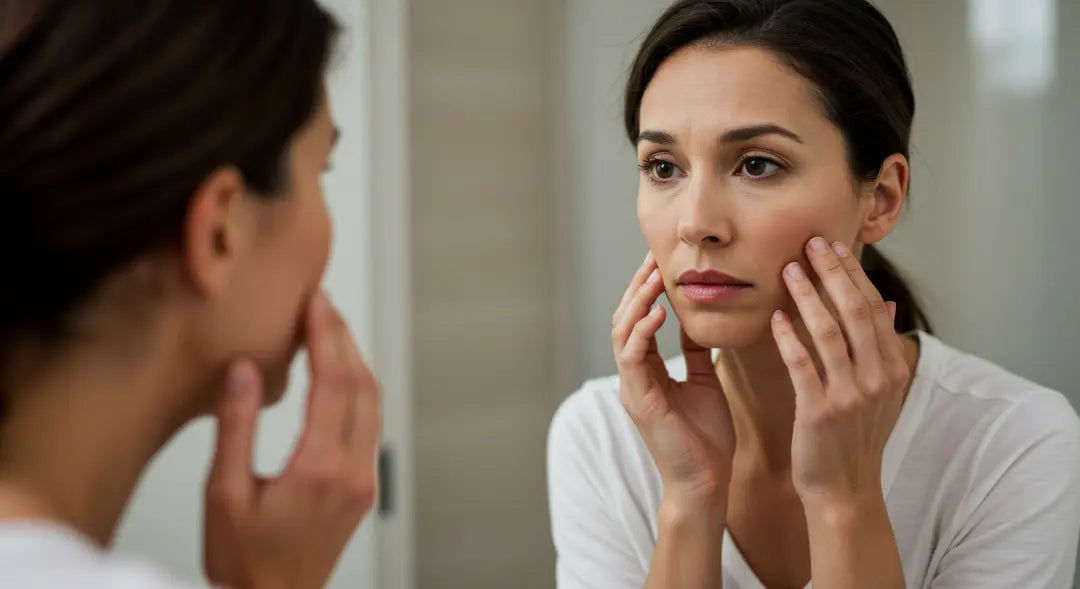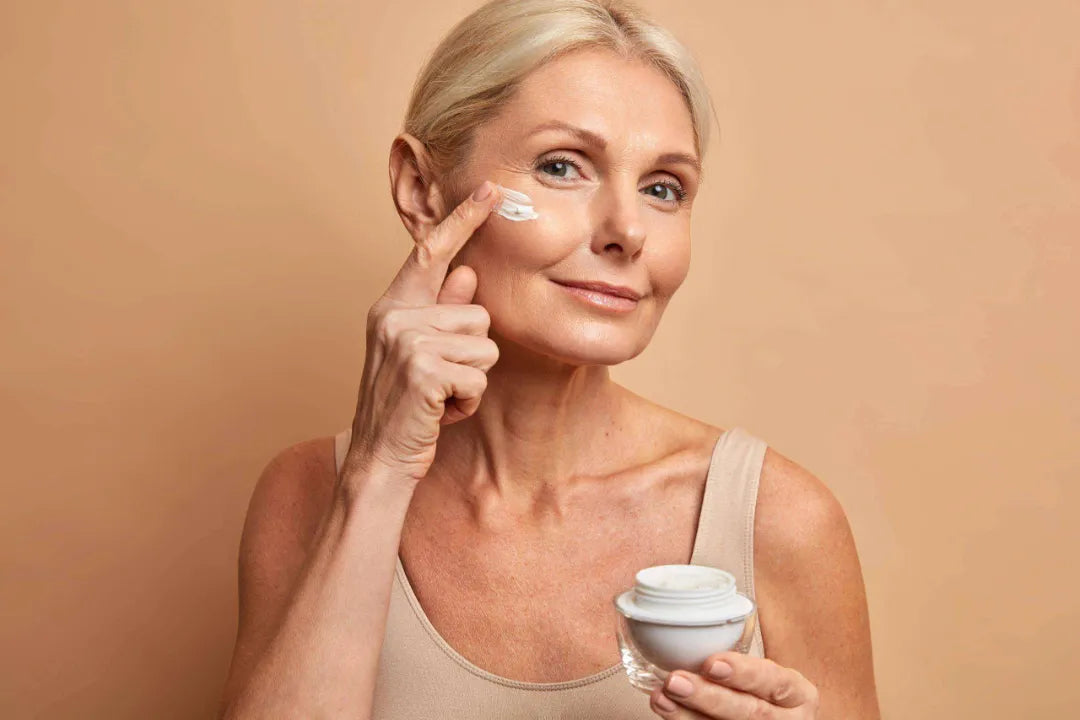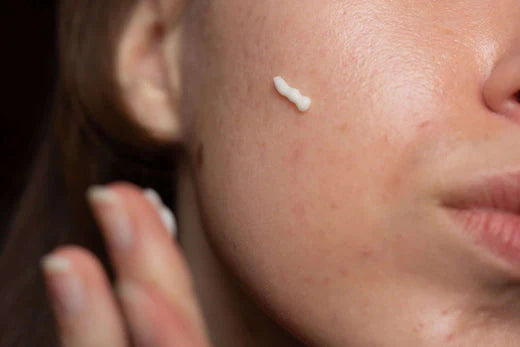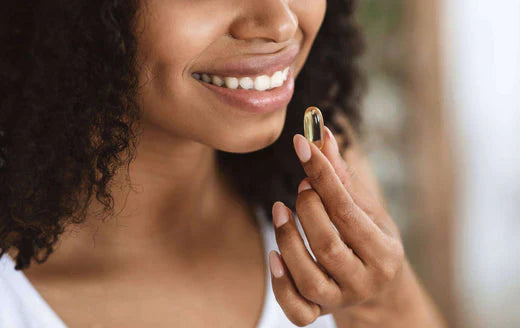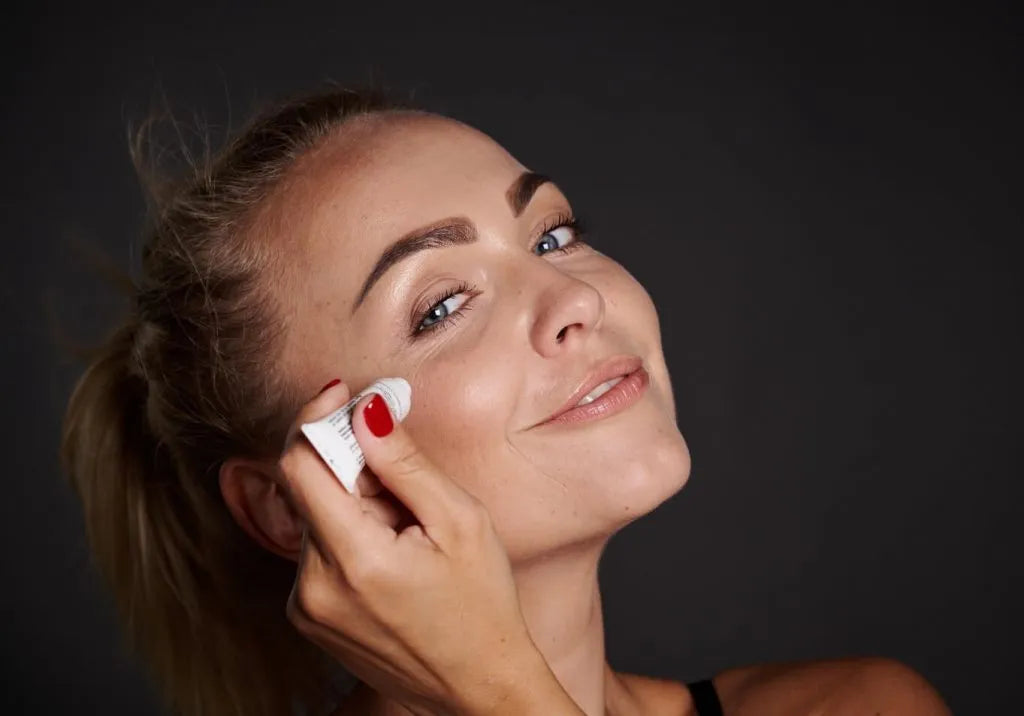Suddenly, you notice an unexpected breakout on your face. What’s really happening? And why now? Menopausal acne doesn’t ask for permission, nor does it follow a chronological rule. It appears when you least expect it. Just at a stage when you thought skin problems were behind you.
If your skin is showing these kinds of changes, perhaps it’s time to pay closer attention. The good news is there are answers and solutions. You don’t need to hide or resign yourself.
What really causes menopausal acne?
To begin with, hormonal changes mark this stage with a direct influence on your skin. Put simply, the drop in oestrogen weakens the skin barrier, while an increase in androgens stimulates the sebaceous glands. As a result, excess sebum is produced, leading to clogged pores.
In addition, local inflammation can increase, encouraging the appearance of those troublesome spots. Stress and external factors also play a role in triggering this reaction. In short, the causes of acne in menopause are a mix of internal and environmental elements (1).
How do hormonal fluctuations affect skin balance?
Without a doubt, constant changes in hormone levels create different imbalances. Hormonal fluctuations at this stage directly affect the production of the natural oils that protect the skin. Consequently, there are two main aspects to consider when it comes to menopausal acne:
-
Androgens that stimulate sebaceous gland activity.
-
The lack of oestrogen, which reduces deep hydration.
Together, these create the perfect environment for lesions and skin infections, such as staph infection, to develop. Sensitivity increases, and the fluctuating cycles make it harder to control hormonal acne in menopause (2).
Why does sebum production increase at this stage?

On the other hand, when the balance between oestrogen and androgens shifts, the skin reacts with an increase in oil secretion. With too little oestrogen to regulate glandular function, the skin becomes oilier and more prone to blockages.
So, have you noticed an unusual shine on your face? Keep in mind that excess sebum contributes to bacterial growth. This, in turn, leads to inflammation and the appearance of annoying spots.
The truth is, many women experience it, although everybody reacts differently. At this point, it’s worth considering tailored treatments that help reduce oil production without stripping the skin (3).
Distinctive features of acne during hormonal decline
In general terms, specific distinctive characteristics appear that require special attention. The most common signs include (4):
-
Breakouts along the jawline, chin, and neck.
-
Inflammation, redness, and painful nodules.
-
Open comedones without excess oil.
-
Combination skin, dry in some areas, oily in others.
Don’t panic if you recognise some of these signs. There are effective skincare strategies for menopausal acne. However, it’s essential to consider both clinical aspects and the internal changes you’re going through.
What are the treatments for menopausal acne?
Equally, to achieve the best results, it’s essential to follow a consistent routine tailored to your specific needs. Today, there are various options available that target both hormonal imbalance and proper cleansing (5):
-
Topical treatments with retinoids and salicylic acid help renew the skin and unclog pores.
-
Products with niacinamide reduce inflammation and even out skin tone.
-
In severe cases, hormone therapies or anti-androgen medication may be recommended to regulate imbalance.
Can acne appear during hormone therapy?
The answer is yes. Although external oestrogen helps ease symptoms, it doesn’t eliminate fluctuations. Sometimes, treatment adjustments are necessary, with proper medical supervision. You can also rely on targeted remedies for menopausal acne to achieve better, longer-term results (6).
How to tell menopausal acne apart from teenage or adult acne
In the same way, treatment for acne varies according to each person’s unique characteristics. Keep in mind that there are key differences depending on the type:
-
Teenage acne is linked to more intense and variable hormonal changes.
-
Adult acne has a different pattern of appearance and tends to be associated with other age-related signs, such as loss of elasticity.
Specific care tips for menopausal acne
As hormone levels decline, changes often trigger those unwanted skin eruptions. However, with the right care, your skin can feel calmer and refreshed. To support your skin, follow these steps (7):
-
Cleanse gently, avoiding harsh scrubbing.
-
Hydrate with lightweight, soothing products.
-
Apply daily sun protection.
-
Choose non-comedogenic textures and maintain healthy habits.
Your skin is going through changes, and while menopausal acne may surprise you, it doesn’t define your beauty or your wellbeing. At Issviva, you’ll find options designed to support you with care and purpose.
Visit our website! Our solutions are created to pamper you, respect your rhythm, and help you embrace this transition with confidence. Remember: every step you take brings you closer to feeling radiant and centred in your wellbeing.
References
-
Gower T. Hormonal Acne: Expert Answers to Common Questions [Internet]. USA: WebMD; 2025 [cited 2025 Sep 2]. Available from: https://www.webmd.com/skin-problems-and-treatments/acne/hormonal-acne
-
Dias MA, Saint M, Mengeaud V, Carballido F, Doat G, Coutinho A, Bagatin E. Unveiling the Nuances of Adult Female Acne: A Comprehensive Exploration of Epidemiology, Treatment Modalities, Dermocosmetics, and the Menopausal Influence [Internet]. USA: National Institutes of Health (NIH); 2024 [cited 2025 Sep 2]. Available from: https://pmc.ncbi.nlm.nih.gov/articles/PMC11034510
-
Cameron K., Benisek A. Sebaceous Hyperplasia: How to Identify and Treat It [Internet]. USA: WebMD; 2025 [cited 2025 Sep 2]. Available from: https://www.webmd.com/skin-problems-and-treatments/what-is-sebaceous-hyperplasia-treatment
-
Cleveland Clinic. Hormonal Acne [Internet]. USA: Cleveland Clinic; 2021 [cited 2025 Sep 2]. Available from: https://my.clevelandclinic.org/health/diseases/21792-hormonal-acne
-
Viscomi B, Muniz M, Sattler S. Managing Menopausal Skin Changes: A Narrative Review of Skin Quality Changes, Their Aesthetic Impact, and the Actual Role of Hormone Replacement Therapy in Improvement [Internet]. USA: National Institutes of Health (NIH); 2025 [cited 2025 Sep 2]. Available from: https://pmc.ncbi.nlm.nih.gov/articles/PMC12374573
-
New York Medical College (NYMC). Menopause Reshapes Skin Health from Hair Loss to Acne [Internet]. USA: New York Medical College (NYMC); 2025 [cited 2025 Sep 2]. Available from: https://www.nymc.edu/newsroom/stories/menopauses-impact-on-common-skin-conditions-study.php
-
Clements, C. How to Best Support Women With Menopausal Acne [Internet]. USA: Dermatology Times; 2025 [cited 2025 Sep 2]. Available from: https://www.dermatologytimes.com/view/how-to-best-support-women-with-menopausal-acne
You May Also Like

JOIN US AND GET 10% OFF
Sign up to our newsletter to access free resources, advice and support.



